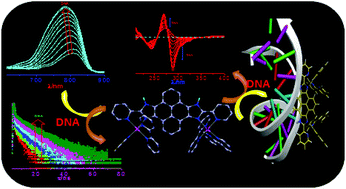Bimetallic Ru(ii) and Os(ii) complexes based on a pyrene-bisimidazole spacer: synthesis, photophysics, electrochemistry and multisignalling DNA binding studies in the near infrared region†
Abstract
We report in this paper the synthesis, characterization, photophysical and electrochemical properties, and detailed DNA binding affinities of two homobimetallic Ru(II) and Os(II) complexes derived from a new bridging ligand consisting of two pyridyl-imidazole coordinating units rigidly coupled with a central pyrene moiety. The structure of the diruthenium complex was confirmed by X-ray crystallography. Both complexes exhibit luminescence at room temperature from their 3MLCT states, with lifetimes of τ1 = 12.6 ns and τ2 = 48.8 ns for the Ru(II) complex (1) and τ1 = 23.7 ns for the Os(II) complex (2). For 2, the luminescence maximum stretches to the NIR region, which is suitable for potential biological applications. Both complexes exhibit two successive one-electron reversible metal-centered oxidations in the positive potential window. Computational studies employing DFT and TD-DFT methods were also performed to assign the experimentally observed optical spectral bands in the complexes. The binding affinities of the complexes towards DNA were thoroughly investigated through a variety of techniques, viz. absorption, luminescence, excited state lifetime, circular dichroism, thermal denaturation, viscosity measurement, and relative DNA binding studies using ethidium bromide. Finally, molecular docking studies were also carried out to visualize the modes of interaction between the complexes and DNA.



 Please wait while we load your content...
Please wait while we load your content...